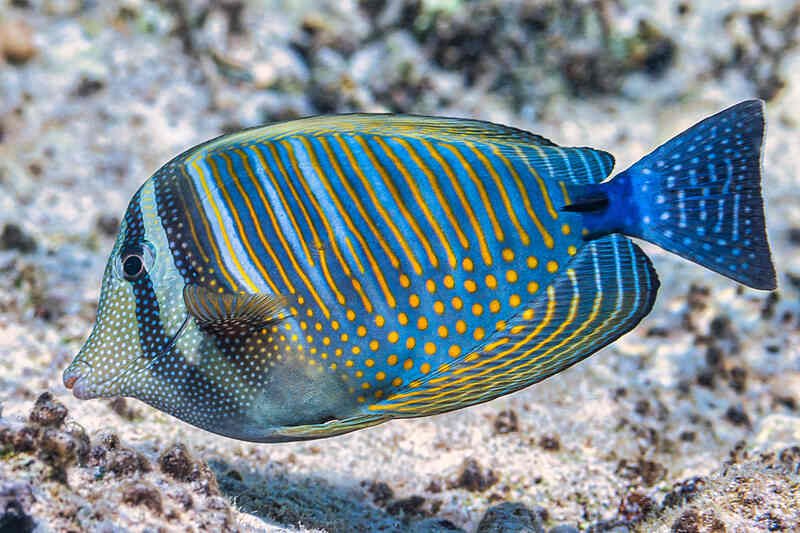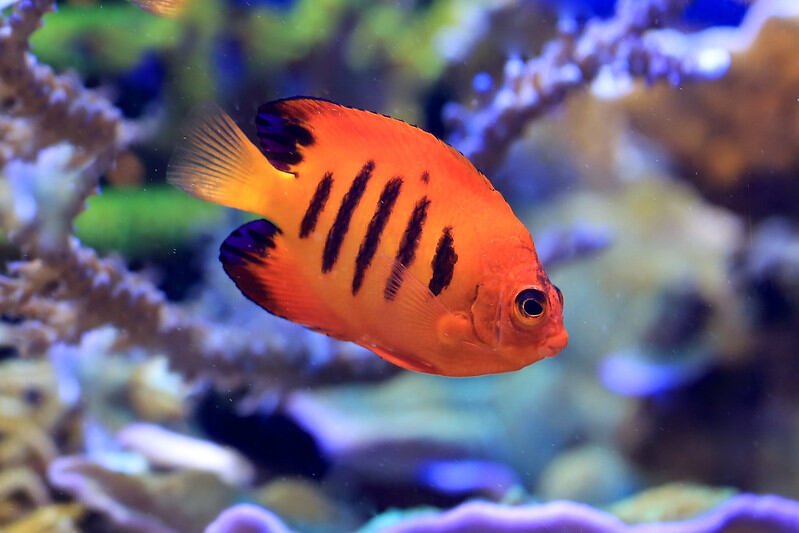When I first introduced a Candy Basslet (Liopropoma carmabi) into my aquarium, I realized its vibrant blend of purples, reds, and oranges made it a true jewel in the tank. Native to deep Caribbean reefs, this fish stands out with beauty and mystery. However, keeping one comes with some unique challenges.
If you’ve been wondering how to care for this stunning species, allow me to walk you through my journey — from setting up the ideal habitat to tackling problems and keeping it thriving.

Getting to Know the Basslet
Basslets are small reef fish, often no longer than 2-3 inches in length. While they’re relatively small, their bold coloration makes them the centerpiece of any aquarium. However, these fish are known to be a bit shy and prefer hiding among rocks, emerging only when they feel safe. Their timid personality requires some thoughtful planning in the tank setup to help them adapt and feel secure.
Setting Up the Perfect Aquarium for Basslet
I learned early on that the environment plays a huge role in ensuring the health of a Basslet. In their natural habitat, these fish reside in deep, rocky reefs, where there are plenty of nooks and crannies to hide. To replicate that, I set up my aquarium with the following considerations:
- Tank Size: I started with a 30-gallon tank, though a minimum of 20 gallons is often recommended. The more space you provide, the more comfortable your basslet will feel. Larger tanks also help maintain water stability, which is essential for sensitive fish like these.
- Live Rocks and Hiding Places: This fish loves to hide in caves and crevices, so I arranged my live rocks to create plenty of shelter. This gave the Basslet multiple spots to retreat, helping it feel safe and reducing its stress.
- Lighting: As they come from deeper waters, Candy Basslets don’t need intense lighting. I kept my lights on the lower intensity side, providing a more natural, dim atmosphere. This also reduced algae growth, making maintenance easier.
- Water Flow: A moderate flow of water replicates their native habitat. I noticed that my Basslet preferred swimming near calmer areas in the tank, where the current wasn’t too strong.
Water Conditions: Keeping It Stable
Water parameters are crucial for keeping any saltwater species healthy, and the Basslet is no exception. Here’s what I learned works best:
- Temperature: 72°F to 78°F (22°C to 25°C)
I aimed to maintain consistent temperatures, as fluctuations could stress the fish. Using an automatic heater and a thermometer made it easy to monitor. - Salinity: 1.022 to 1.025
I kept my salinity within this range by topping off evaporated water with fresh water regularly. Having a refractometer to measure salinity accurately was a game-changer. - pH: 8.1 to 8.4
A stable pH is essential. I performed weekly water tests to ensure my pH didn’t fluctuate. When needed, I used supplements to keep it within the optimal range. - Nitrate and Ammonia Levels: Near zero
Clean water is essential for the Basslet’s health. I made sure to perform regular water changes — around 10-15% weekly — to keep the nitrate levels low. Using a protein skimmer also helped keep my water quality high.
Feeding the Candy Basslet: What Works Best
When it came to feeding, I quickly realized that Basslets can be a bit finicky. They consume zooplankton and tiny crustaceans in the wild. Here’s what worked for me:
- Live Foods: At first, my basslet was reluctant to eat anything but live brine shrimp. Introducing live foods helped it settle into the new environment.
- Frozen Foods: I gradually transitioned to frozen options like mysis shrimp, krill, and copepods. Offering a varied diet ensured the fish received all the nutrients it needed.
- Feeding Schedule: I fed the Basslet twice daily in small portions. I found that overfeeding led to waste buildup and potential water quality issues, so it was important to stick to small, manageable portions.
- Feeding Tip: Since Basslets can be shy, I noticed it preferred eating when other fish were not around. Sometimes I had to dim the lights and target-feed using a turkey baster to ensure it got its fair share of food.
Choosing Tankmates: Peaceful Companions
Selecting the right tankmates was a critical part of creating a harmonious environment. Basslets are generally peaceful but shy, so I avoided keeping them with overly aggressive or boisterous fish.
- Safe Tankmates:
Some good companions I found include small gobies, clownfish, and firefish. These species are peaceful and don’t harass the basslet. - Fish to Avoid:
I made sure to avoid larger predators, such as lionfish or triggerfish, which could intimidate or harm the Candy Basslet. Fast-moving fish like damselfish were also a poor choice, as they caused stress by constantly darting around the tank. - Territorial Issues:
Although Basslets are peaceful, they can get territorial with other basslets or similar fish. To avoid aggression, I kept only one Candy Basslet in my aquarium, as they can become hostile toward their own kind.
Handling Health Issues and Stress Management
Fortunately, my Basslet stayed healthy for the most part, but I was always on the lookout for signs of illness or stress.
- Stress Management:
When stressed, Basslets might refuse food or hide excessively. I made sure to maintain stable water conditions and provide hiding spaces to reduce stress. - Ich and Marine Velvet:
These fish are prone to common saltwater diseases like Ich and marine velvet. I always quarantined new fish before introducing them into the main tank to prevent outbreaks. - Medications:
When I noticed early signs of Ich (white spots on the fins), I treated the tank with copper-free medication. Basslets can be sensitive to copper, so I made sure to use safe alternatives.
A Challenging Endeavor
Breeding Basslets is a tricky task and something I haven’t yet mastered. These fish are hermaphroditic — meaning they have both male and female reproductive organs — but they don’t often spawn in captivity. If you’re looking to breed them, here are a few things to consider:
- Pairing:
It’s challenging to create a compatible pair since aggression between Candy Basslets is common. Some aquarists have had success by introducing them as juveniles and letting them mature together. - Spawning Conditions:
Reports suggest that a low-light setting and calm environment are essential for spawning. Maintaining pristine water conditions is also crucial. - Raising Fry:
Even if spawning occurs, raising the fry can be difficult, as they require specialized food and care. I plan to experiment more with breeding in the future, but for now, I enjoy keeping the Basslet as a single specimen.
My Key Takeaways on Basslet Care
Caring for a Basslet has been a rewarding experience. However, it’s important to be patient and attentive to their needs. Here are some of the most important things I’ve discovered thus far:
- Hiding Spaces Matter:
Providing plenty of hiding places makes a huge difference. The more secure your basslet feels, the more likely it is to come out and explore. - Stable Water Conditions Are Essential:
Basslets are sensitive to water changes, so consistent water maintenance is key to their health. - Feeding Requires Patience:
These fish can be picky eaters. Don’t be discouraged if they refuse food at first — keep trying with live or frozen options. - Choose Tankmates Carefully:
Avoid aggressive fish that could stress or harm your basslet. Stick to peaceful companions to create a harmonious tank. - Observe Regularly:
Daily observation helps catch any signs of illness early. Quick action can make the difference between a healthy fish and a disaster.
Conclusion
In my experience, keeping a Basslet is incredibly fulfilling. Their vibrant colors, graceful movements, and shy demeanor make them a joy to watch. However, they require thoughtful care, especially when it comes to tank setup, feeding, and water quality. With patience and the right environment, these little fish will reward you with their beauty for years to come. Whether you’re an experienced aquarist or a dedicated beginner, the Basslet is a wonderful addition to any saltwater tank.
Taking care of a Basslet has been an enriching journey, and I hope my experience helps you create a happy, healthy environment for your fish. If you’re considering adding one to your aquarium, I say go for it — the rewards far outweigh the challenges!



